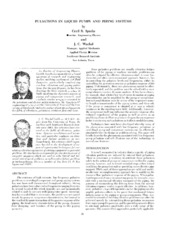| dc.description.abstract | The existence of high intensity, low frequency pulsation problems in centrifugal compressor and pump piping systems has now been well documented throughout industry. Strong pulsations have been observed at frequencies ranging from two to several hundred Hz which typically are not harmonically related to (and do not vary with) pump rotor speed. Investigation has revealed that in most cases, the problem is not caused simply by pump or compressor characteristics, but instead is the result of dynamic interaction of the passive response of the piping, the head curve characteristics of the pump, dynamic flow damping, and location of the pump in the piping geometry. Since pulsation problems are usually vibration fatigue problems of the piping or machine internals, problems can often be mitigated by effective vibration control. A more fundamental and often more economical approach, however, lies in controlling the pulsation levels and frequencies, either by controlling the generation sources or pulsation response of the piping. Unfortunately, these two phenomena cannot be effectively separated, and the problem must be solved with a more comprehensive system dynamic analysis. It has been shown, for example, that relative low level vortex formation at piping discontinuities can be amplified by the pump or compressor, but such amplification must be at one of the responsive acoustic length resonant modes of the piping system, and then only if the pump or compressor is situated at or near a velocity maximum in the standing wave field. Additionally, however, the compressor itself may influence the acoustic response (distributed impedance) of the piping as well as serve as an amplifying element. Flow or pressure drop is also an important factor in sustaining such pulsations as it affects modal damping. Techniques have now been developed whereby many of the phenomena associated with low frequency pulsations in centrifugal pump and compressor systems can be effectively simulated either for design or problem solving. The paper will briefly describe the phenomena associated with low frequency pump pulsations and will illustrate use of the technology in several case histories. | en |


